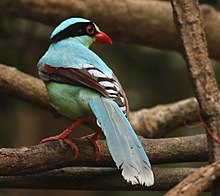Common green magpie
This article needs additional citations for verification. (July 2017) |
| Common green magpie | |
|---|---|

| |
| Nominate subspecies | |
| Scientific classification | |
| Domain: | Eukaryota |
| Kingdom: | Animalia |
| Phylum: | Chordata |
| Class: | Aves |
| Order: | Passeriformes |
| Family: | Corvidae |
| Genus: | Cissa |
| Species: | C. chinensis
|
| Binomial name | |
| Cissa chinensis (Boddaert, 1783)
| |

| |
| Native distribution of the common green magpie | |
The common green magpie (Cissa chinensis) is a member of the crow family, roughly about the size of the Eurasian jay or slightly smaller. In the wild specimens are usually a bright green colour (often fades to turquoise in captivity or with poor diet as the pigment is carotenoid based[2]), slightly lighter on the underside and has a thick black stripe from the bill (through the eyes) to the nape. Compared to the other members of its genus, the white-tipped tail is quite long. This all contrasts vividly with the red fleshy eye rims, bill and legs. The wings are reddish maroon.
It is found from the lower Himalayas in north eastern India in a broad south easterly band down into central Thailand, Malaysia, Sumatra and northwestern Borneo in evergreen forest (including bamboo forest), clearings and scrub.
This bird seeks food both on the ground and in trees, and takes a very high percentage of animal prey from countless invertebrates, small reptiles, mammals and young birds and eggs. It will also take flesh from a recently killed carcass.
The nest is built in trees, large shrubs and often in tangles of various climbing vines. There are usually 4–6 eggs laid.
The voice is quite varied but often a harsh peep-peep. It also frequently whistles and chatters.
Taxonomy

The common green magpie was described by the French polymath
The common green magpie is now one of four species that are placed in the genus Cissa that was introduced by the German zoologist Friedrich Boie in 1826 with the common green magpie as the type species.[7][8] The generic name is from the Ancient Greek kissa meaning a "jay" or "magpie". The specific epithet chinensis was chosen by Boddaert in the mistaken belief that the specimen illustrated by Martinet had come from China.[9]
Five subspecies are recognised:[8]
- C. c. chinensis (Boddaert, 1783) – Himalayas to south China, north Indochina, Thailand and Myanmar
- C. c. klossi Delacour & Jabouille, 1924 – central Indochina
- C. c. margaritae Robinson & Kloss, 1919 – Lang Bian Mountains (south Vietnam)
- C. c. robinsoni Ogilvie-Grant, 1906 – Malay Peninsula
- C. c. minor Cabanis, 1850 – Sumatra and Borneo
References
- . Retrieved 12 November 2021.
- ^ Shelton, L. C. "Successful Breeding of the Long--tailed Cissa at the Houston Zoo". AFA Watchbird. 16 (5): 8–11.
- ^ Buffon, Georges-Louis Leclerc de (1775). "Le rolle de la Chine". Histoire Naturelle des Oiseaux (in French). Vol. 5. Paris: De L'Imprimerie Royale. pp. 181–182.
- Daubenton, Louis-Jean-Marie (1765–1783). "Rollier, de la Chine". Planches Enluminées D'Histoire Naturelle. Vol. 7. Paris: De L'Imprimerie Royale. Plate 620.
- ^ Boddaert, Pieter (1783). Table des planches enluminéez d'histoire naturelle de M. D'Aubenton : avec les denominations de M.M. de Buffon, Brisson, Edwards, Linnaeus et Latham, precedé d'une notice des principaux ouvrages zoologiques enluminés (in French). Utrecht. p. 38, Number 620.
- .
- ^ Boie, Friedrich (1826). "Generalübersicht der ornithologischen Ordnungen, Familien und Gattungen". Isis von Oken (in German). 19. Cols 969–981 [975 Fn. 2].
- ^ a b Gill, Frank; Donsker, David, eds. (2019). "Crows, mudnesters, birds-of-paradise". World Bird List Version 9.2. International Ornithologists' Union. Retrieved 25 August 2019.
- ISBN 978-1-4081-2501-4.

